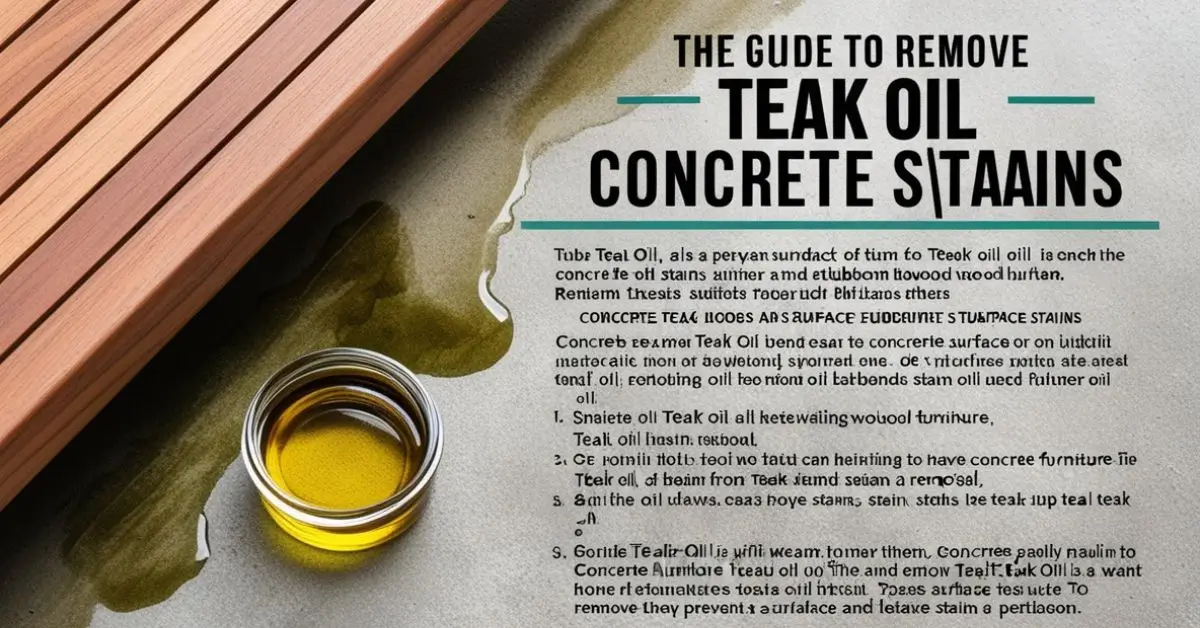How to Remove Teak Oil Stain from Concrete. Teak oil is a widely used product to maintain and beautify wooden furniture, but when it spills onto concrete surfaces, it can leave stubborn stains. Due to concrete’s porous nature, oil easily seeps in, making removal a challenge. This guide outlines detailed methods to remove teak oil stains effectively and prevent them in the future.
Why Teak Oil Stains Concrete
Concrete, though tough and durable, has a porous structure that absorbs liquids quickly. When teak oil comes into contact with a concrete surface, it penetrates the pores, leaving behind unsightly, oily marks. Addressing the stain as soon as possible reduces the difficulty of removing it and increases the chances of restoring the surface to its original condition.
Step-by-Step Methods to Remove Teak Oil Stains from Concrete
1. Immediate Absorption with Cat Litter or Sawdust
One of the first steps in dealing with an oil spill is to absorb as much oil as possible before it seeps deeper into the concrete.
How to Use:
- Cover the stain immediately with an absorbent material like cat litter, sawdust, or even baking soda.
- Press it down lightly to ensure contact with the surface.
- Let it sit for at least 4–6 hours or overnight for better results.
- Sweep up the material and dispose of it properly.
This step won’t eliminate the stain entirely but will reduce the oil residue significantly.
2. Dish Soap and Hot Water Scrubbing
Dish soap is a great degreaser and can break down oil stains effectively when combined with hot water.
Steps:
- Mix a few tablespoons of dish soap in a bucket of hot water.
- Pour the mixture over the stain and let it sit for a couple of minutes.
- Use a stiff-bristled brush to scrub the area thoroughly, working in circular motions.
- Rinse the area with clean water and repeat the process if needed.
Pro Tip: This method works best for fresh or light stains.
3. Baking Soda Paste
Baking soda is a natural abrasive and an effective stain remover for oil-based spills.
How to Use:
- Mix baking soda with a small amount of water to form a thick paste.
- Spread the paste generously over the stain.
- Scrub gently with a brush and let it sit for 15–20 minutes.
- Rinse the area with warm water and evaluate the results.
For older or deeper stains, repeating this process may be necessary.
4. White Vinegar for Natural Cleaning
White vinegar’s acidic nature can break down the oil residue effectively.
Steps:
- Pour white vinegar directly onto the stained area.
- Let it soak for 10–15 minutes to penetrate the stain.
- Scrub with a stiff brush and rinse thoroughly with water.
- If the stain persists, reapply vinegar and repeat the process.
This method is eco-friendly and works well for moderately stubborn stains.
5. Commercial Concrete Cleaners
If home remedies don’t completely remove the stain, specialized concrete cleaners designed for oil spills can help.
How to Use:
- Choose a cleaner labeled for oil and grease removal.
- Follow the manufacturer’s instructions carefully, as some products require dilution.
- Apply the cleaner to the stain and let it sit for the recommended time.
- Scrub the area and rinse thoroughly.
These cleaners are particularly effective for older or set-in stains but may involve additional cost.
6. Pressure Washing
For extensive or persistent stains, pressure washing can provide a deep clean.
Procedure:
- Start by wetting the concrete to prevent damage.
- Use a pressure washer at a low setting to test the surface.
- Gradually increase the pressure to remove the stain.
- Move the washer in consistent strokes to avoid uneven cleaning.
This method is effective but should be used cautiously to avoid damaging the concrete.
Comparison of Methods
| Method | Effectiveness | Ease of Use | Cost | Best For |
|---|---|---|---|---|
| Cat Litter or Sawdust | Moderate | Easy | Low | Fresh spills |
| Dish Soap and Hot Water | High | Easy | Low | Light stains |
| Baking Soda Paste | High | Easy | Low | Moderate stains |
| White Vinegar | Moderate | Easy | Low | Eco-friendly cleaning |
| Commercial Cleaners | High | Moderate | Medium | Older, set-in stains |
| Pressure Washing | High | Moderate | High | Deep and widespread stains |
Preventing Future Stains
Taking preventive measures can save you the hassle of dealing with oil stains later.
1. Seal the Concrete
Concrete sealers create a protective barrier, preventing oil and other substances from seeping in. Applying a sealer every 1–2 years ensures long-term protection and makes cleaning spills much easier.
2. Immediate Cleanup
Addressing spills immediately is the best way to prevent deep staining. Always have absorbent materials like cat litter or baking soda on hand for emergencies.
3. Use Protective Covers
Placing mats or protective covers under wooden furniture treated with teak oil can prevent spills from reaching the concrete surface.
Safety Precautions
When cleaning teak oil stains, keep the following safety measures in mind:
- Wear Gloves and Eye Protection: Cleaning agents can irritate your skin and eyes.
- Ensure Proper Ventilation: If using commercial cleaners, work in a well-ventilated area to avoid inhaling fumes.
- Dispose of Materials Responsibly: Oily absorbent materials should be disposed of according to local regulations.
Visual Demonstration
Watching a video tutorial can provide additional clarity on removing oil stains from concrete. Search for detailed visual guides on popular video platforms for step-by-step demonstrations.
Final Thoughts
Removing teak oil stains from concrete requires patience, but with the right methods, your surfaces can be restored to their original state. Start with simple household remedies and escalate to specialized products or equipment as needed. By combining effective cleaning techniques with preventive measures, you can keep your concrete surfaces looking pristine for years to come.












